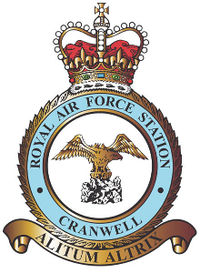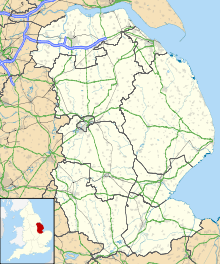- RAF Cranwell
-
This article is about the Royal Air Force station. For the officer training establishment which lodges at RAF Cranwell, see Royal Air Force College Cranwell.
Royal Air Force Cranwell IATA: none – ICAO: EGYD Summary Airport type Military Operator Royal Air Force Location Cranwell Elevation AMSL 218 ft / 66 m Coordinates 53°01′49″N 000°29′00″W / 53.03028°N 0.4833333°WCoordinates: 53°01′49″N 000°29′00″W / 53.03028°N 0.4833333°W Map Location in Lincolnshire Runways Direction Length Surface ft m 01/19 4,793 1,461 Asphalt 08/26 6,827 2,081 Asphalt 08R/26L 2,497 761 Grass RAF Cranwell 
Station badgeActive 1 April 1916 (as RNAS base) – Present Country United Kingdom Branch  Royal Air Force
Royal Air ForceType Training Role Officer and Aircrew Training Based near Sleaford, England Motto Alitum Altrix
Latin:"Nurture The Winged"Commanders Current
commanderGroup Captain D J Waddington RAF Cranwell (ICAO: EGYD) is a Royal Air Force station in Lincolnshire close to the village of Cranwell, near Sleaford. It is currently commanded by Group Captain Dave Waddington. The main building of RAF Cranwell is noted for its distinctive dome, visible from most of the surrounding roads.
Contents
Origins
The history of military aviation at Cranwell goes back to November 1915,[1] when the Admiralty requisitioned 2500 acres (10 km²) of land from the Earl of Bristol's estate.[1] And on 1 April 1916, the Royal Naval Air Service, Training Establishment, Cranwell was officially born.[1] The first commander was Commodore Godfrey M. Paine.
As the naval personnel were held on the books of River Medway, this gave rise to a misconception that Cranwell was first established as HMS Daedalus.[2]
With the establishment of the Royal Air Force as an independent service in 1918, the RNAS Training Establishment became RAF Cranwell.[3] T. E. Lawrence, perhaps better known as Lawrence of Arabia, was stationed at RAF Cranwell just after the war, in 1926, where he wrote a revised version of his Seven Pillars Of Wisdom.[4][5] He mentioned the nearby village of Navenby in a letter to a friend at the time, saying: "I'm too shy to go looking for dirt. That's why I can't go off stewing into the Lincoln or Navenby brothels with the fellows. They think it's because I'm superior: proud, or peculiar or 'posh', as they say: and its because I wouldn't know what to do, how to carry myself, where to stop. Fear again: fear everywhere."[6][7]
Cranwell became the entry point for all those who wished to become permanent officers in the RAF, and the selection process was extremely stringent. Initially the course took two years, but by the 1950s this had expanded to three. Until 81 Entry, arriving in September 1959, all flying training took place at the College; basic training on Percival Provosts and advanced training on either De Havilland Vampires or Gloster Meteors. With the arrival of 81 Entry, the academic syllabus was improved to allow cadets to gain degrees in humanities, or AFRAeS. To enable this to happen in the three year course, only basic training was carried out at Cranwell on the new Jet Provosts Mks 3 and 4. Cadets still received their wings on passing out of Cranwell, but went on to advanced flying courses at either RAF Oakington or RAF Valley. In 1962 Whittle Hall was built to support the new syllabus, opened by Sir Frank Whittle. This meant that the old East and West Camps, which had been used for lectures, were re-deployed for other activities.
From 1917 RAF Cranwell was served by its own dedicated railway station on a single track branch line from Sleaford. The spur line was closed in 1956 and all the track removed. However, the original station building still stands and today remains in use as RAF Cranwell's main guardroom.
The motto - Altium Altrix - translates roughly to Nurture the highest, and this motto can be found in gold print above the main doors of CHOM (College Hall Officers Mess). Also on the top of the dome of the Mess is a connection to the RNAS past life of the station, that makes Cranwell unique in RAF history and a record holder as well; RAF Cranwell has the furthest lighthouse from the sea in the UK, and the only RAF station to have a permanent lighthouse on its grounds.
Jet engine history
Sir Frank Whittle attended RAF Cranwell in the late 1920s. It was here that he formulated many of his ideas for the jet engine, and it was at Cranwell on 15 May 1941 that the first flight of the Gloster E.28/39 took place.
Current functions
RAF College Cranwell
Cranwell is home to the Royal Air Force College (RAFC), which trains the RAFs new officers on a 32-week course. It is thus the RAF equivalent of Sandhurst or the Britannia Royal Naval College, and is considered by some to be the spiritual home of the RAF.
RAF recruitment
The station is home to the Officer and Aircrew Selection Centre (OASC), where all applicants to the RAF as Officers or non-commissioned aircrew, are put through a 4 day rigorous selection process. The OASC is currently commanded by Group Captain Tom McWilliams. The selection process features aptitude testing, medical examinations, interviews, plus a number of challenging individual plus team planning and initiative exercises.
It is also home to the Inspectorate of Recruiting (IofR) - the division of the RAF responsible for providing recruiting and outreach services via the network of Armed Forces Careers Offices (AFCOs) around the UK.
Around the 1970s the RAF introduced the Direct Entry Scheme, in which a fresh graduate from any university could be admitted into RAF after a short training period at RAFC Cranwell. Originally titled the Professionally Qualified and Re-entrant Course (PQRE) since 1978 the course has been known as the Specialist Entrant and Re-entrant Course (SERE). The course has trained RAF Chaplains, officer ranked nurses joining the PMRAFNS from the NHS, officers transferring to the RAF from the Army or Navy, former officers re-joining the RAF and, until 1992, Royal Observer Corps wholetime officers. Most entrants emerged with the rank of Flight Lieutenant with chaplains being commissioned as Squadron Leaders.
Royal Air Force College
The Royal Air Force College was also an engineering school offering HND and CNAA degrees courses. The students are mostly commissioned officers from RAF as well as those from the Commonwealth countries. The class sizes were very small (25), and the students had very close attention from their lecturers and instructors. RAF College also offered Non-MOD courses especially customised for air force officers from the Commonwealth countries.
Headquarters Central Flying School
HQ CFS has been located at RAF Cranwell since 1995 when it moved from RAF Scampton. Central Flying School is the longest established military flying school in the world and currently trains all RAF QFI flying instructors.
Air Training Corps
Since the mid-1990s, Cranwell has been home to Headquarters, Air Cadets, and the Air Cadet Organisation's Adult Training Facility.
Sea Cadet Corps
Since 2011 the Eastern Area Sea Cadets Heaquarters have been based on site.
Flying Squadrons
RAF Cranwell is home to three RAF flying squadrons. 16 (R) Squadron conduct Elementary Flying Training on the Tutor, 45(R) Squadron conduct multi-engined pilot training with the King Air, and 55(R) Squadron conducts Airmen Aircrew Initial Training and General Service Training.
Other
No.3 Flying Training School (FTS), training navigators and non-commissioned aircrew, is also based there. Cranwell is also home to two of the RAF bands, namely The Band of the Royal Air Force College and The Band of the Royal Air Force Regiment.
See also
- Royal Air Force College Cranwell
- Cranwell
- RAF Harlaxton
Notes
- ^ a b c Halpenny (1981), p.74
- ^ RAF Cranwell: College History. Royal Air Force. 2006. http://www.raf.mod.uk/rafcranwell/aboutus/collegeHistory.cfm. Retrieved 2007-06-30
- ^ Halpenny (1981), p.75
- ^ Hastings, Chris; Bisset, Susan; Edwardes, Charlotte (2007-06-09). "T E Lawrence's 'mistress' was an orphan". The Daily Telegraph (London). http://www.telegraph.co.uk/news/uknews/1396686/T-E-Lawrences-mistress-was-an-orphan.html. Retrieved 2008-02-20.
- ^ Hart, Basil (1936). T. E. Lawrence in Arabia and After. J. Cape. p. 424. ISBN 0-8371-4258-X.
- ^ Wilson, Jeremy (1990). Lawrence of Arabia: The Authorized Biography of T.E. Lawrence. Atheneum. p. 766. ISBN 0-689-11934-8.
- ^ Knightley, Phillip (1970). The Secret Lives of Lawrence of Arabia. McGraw-Hill. p. 294. ISBN 0-17-135010-3.
References
- Halpenny, Bruce Barrymore. 1981. Action Stations Vol.2: Wartime Military Airfields of Lincolnshire and the East Midlands ISBN 978-1852604059
External links
- RAF Cranwell website
- Airport information for EGYD at World Aero Data. Data current as of October 2006.
- Airfields & Aviation Memorials
Categories:- Royal Air Force stations in Lincolnshire
- Airports in England
Wikimedia Foundation. 2010.

